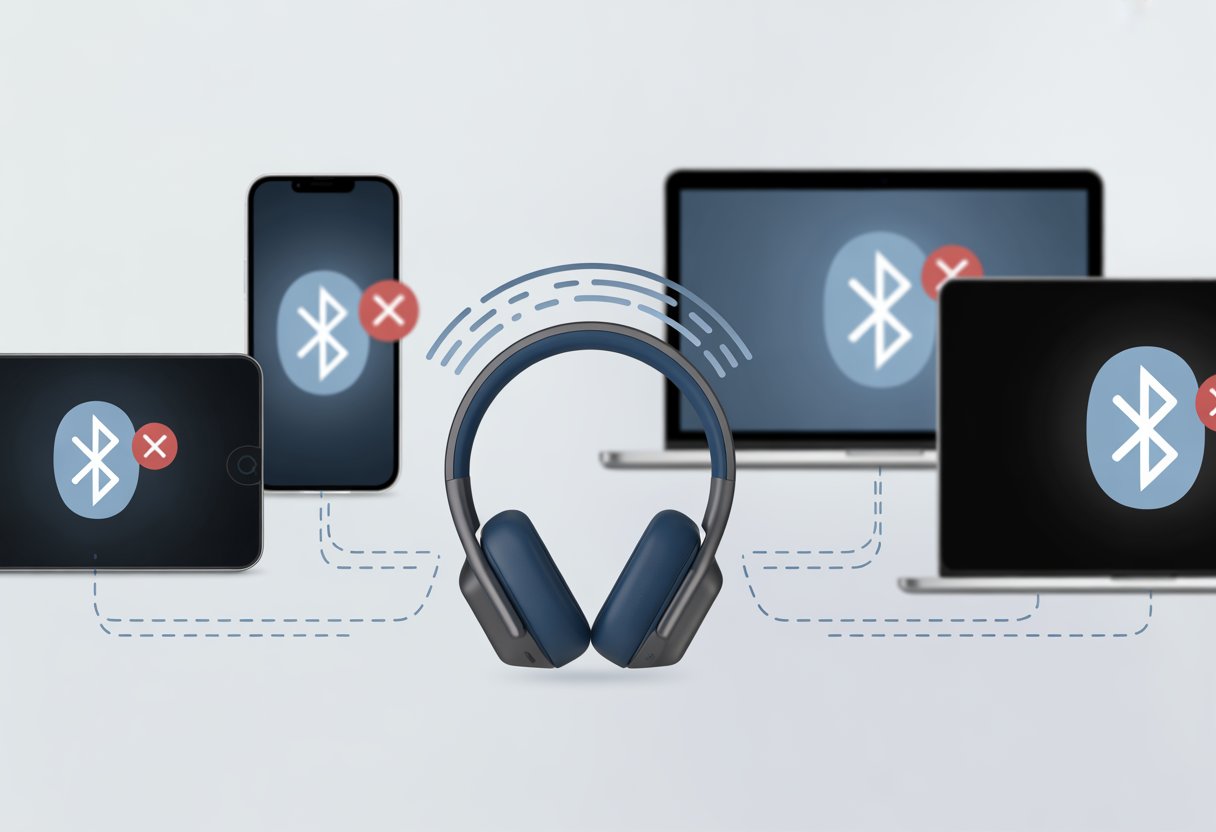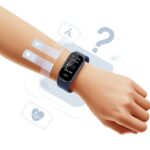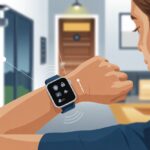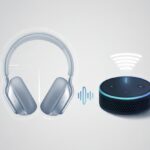Let’s be honest—Bluetooth headphones make us feel futuristic, but they also drop us back to reality when they refuse to cooperate. We’ve all tried juggling a phone, laptop, and tablet, only to find out our headphones want to stick with just one device at a time.
Most Bluetooth headphones can’t connect to more than one device at once because the technology focuses on one-on-one connections, not group chats (learn more about the standard).

If you’ve ever tried to connect your headphones to your laptop while still grooving to music from your phone, you know the pain. Headphones just can’t seem to multitask, and it’s a little annoying.
But don’t give up just yet—there are settings and features that can help. Sometimes, one small change can make everything work.
How Bluetooth Connections Work With Headphones
Bluetooth headphones might feel like magic, but there’s a method behind the madness. Let’s dig into how they pair, why there are limits, and how their memories work (spoiler: headphones don’t forget…unless we make them).
Pairing Headphones With Bluetooth Devices
When we get a new pair of Bluetooth headphones, they usually ask us to pair them—like a puppy waiting for attention. Pairing just means connecting the headphones to a device, such as a phone or laptop, using wireless signals.
Here’s how it usually goes:
- We put the headphones into pairing mode by holding a button until they start blinking.
- On our device, we search for Bluetooth devices and tap the headphone’s name.
- The headphones and device exchange a secret handshake, or a pairing code.
After pairing, the headphones remember our device. Most headphones can store several pairings.
Some cheaper models get confused and act like every device is a stranger, which can get old fast.
Understanding Connection Limits
Pairing and connecting aren’t the same thing. Even if we’ve paired with five devices, the headphones usually only connect to one or maybe two at a time.
Bluetooth keeps things simple—imagine only one mic at karaoke night. Most Bluetooth headphones stick to a single active connection.
A few fancy models support “multipoint,” so we can connect to two devices at once (switching between cat videos and work calls, for example). Sony’s support page mentions that swapping between devices often means diving into Bluetooth settings.
So, our headphones aren’t ignoring us—they just can’t talk to everyone at once.
The Role Of Headphone Memory
Headphones come with a tiny bit of memory. They use it to remember which devices they’ve paired with, not to store our playlists.
That’s why, after a successful pairing, headphones often auto-connect to our phone the next time we turn them on.
But this memory has limits. Most headphones remember between 3 and 8 devices.
When we hit that limit, pairing a new device pushes an old one out—like musical chairs, but with more beeping.
If things get weird, a quick reset helps headphones forget old pairings and start over. This troubleshooting guide shows how a reset can fix pairing mishaps.
What Is Multipoint And Why Should You Care?
Let’s face it, with more gadgets than kitchen magnets, we need headphones that can keep up. Multipoint Bluetooth tries to make juggling our devices a bit less painful.
Definition Of Multipoint Technology
Multipoint is a Bluetooth technology that lets headphones connect to more than one device at once. We can stay connected to, say, a phone and a laptop, without breaking a sweat.
If a call comes in on our phone while music plays from our computer, we don’t have to disconnect or re-pair anything.
Most headphones can remember up to eight devices, but only multipoint lets them use more than one at the same time. Multipoint does the juggling for us, so we don’t have to keep switching.
Think of it as a party where two friends get to hang out with us at once, while the rest wait outside. If you want the technical scoop, Bluetooth multipoint explains how it works.
Multipoint Vs. Traditional Bluetooth
Let’s compare. Traditional Bluetooth headphones connect to one device at a time.
If we want to use another device, we have to disconnect and reconnect. It’s like playing Bluetooth hopscotch—honestly, not fun.
Table: Multipoint vs. Traditional Bluetooth
| Feature | Multipoint | Traditional Bluetooth |
|---|---|---|
| Devices connected at once | 2 (sometimes more) | 1 |
| Switching needed? | No (auto switch) | Yes (manual switch) |
| Headache from pairing? | Rare | Frequent |
Multipoint saves us from digging through menus every time someone calls or texts on another device. Traditional Bluetooth headphones act like loyal dogs—sticking to one person. Multipoint is more like a sly cat—jumping between laps as it pleases.
Benefits Of Switching Between Connected Devices
Switching between devices without reconnecting is one of those features we never knew we needed. We can watch a movie on our tablet, then answer a call from our phone, all without missing a beat.
This is especially handy if we’re working from home—or, let’s be honest, from the couch. No more scrambling through Bluetooth settings or yelling, “Hold on!” Multipoint takes care of the chaos, letting us switch between connected devices automatically.
Here’s why multipoint rocks:
- No more manual switching
- Fewer missed calls or notifications
- Saves us time (and maybe a little dignity) during meetings
Less tech stress means we can just enjoy our music, podcasts, or calls.
Common Reasons Bluetooth Headphones Don’t Connect To Multiple Devices
Bluetooth headphones often struggle with more than one device. It’s not personal—it’s just how the technology and our gadgets work.
Product Limitations
Honestly, some headphones just aren’t made for socializing. Many models only connect to one device at a time.
If our headphones support multiple connections, it’s not always obvious or smooth. Sometimes we see “Multipoint” on the box, which means we can connect to two devices at once.
But if both devices send audio at the same time, things get weird—like a tug-of-war with our ears. Other headphones remember several devices but only connect to one at once.
We have to disconnect from one before moving to the next. Forgetting which device is paired leads to lots of confused tapping and maybe a few sighs. For more info, check out why some headphones can connect to multiple devices at once, while others can’t.
Outdated Firmware Or Software
Sometimes, headphones just need a software update. Old firmware can make multiple connections a headache.
Manufacturers push updates to fix bugs and improve compatibility. If we’re still using the firmware from when we bought the headphones, things might not work as well as they could.
It’s worth checking the manufacturer’s app or website for updates. Keeping things up to date can help our headphones play nicer with our gadgets.
Device Compatibility Issues
Even if our headphones are ready, the devices we use might not be. Older phones, tablets, or laptops sometimes use outdated Bluetooth versions.
Newer headphones might not want to “hang out” with older tech. For example, a headset built for Bluetooth 5.0 may not play well with a phone stuck on Bluetooth 4.1.
Interference, distance, or certain Bluetooth profiles can cause even more drama. According to experts, sometimes our gear just won’t get along, no matter what.
User Configuration Errors
We love pressing buttons and poking at settings, but sometimes we make things worse. Juggling multiple connections means knowing how to handle Bluetooth menus.
If we leave Bluetooth on with several paired devices nearby, headphones can get confused and ghost us. Some headphones require us to disconnect from one device before connecting to another.
Others need a special pairing mode—usually hidden behind a weird button combo. Double-check that Bluetooth on the unwanted device is off, or at least not searching.
Sometimes a factory reset clears things up. When all else fails, yelling at our headphones probably won’t help, but hey, it’s worth a try. For more troubleshooting tips, see why using Bluetooth with multiple devices can be tricky.
Product-Specific Features And Restrictions
Not all Bluetooth headphones are created equal. Some give us multipoint connections right away, while others make us pick one device at a time—like a never-ending game of musical chairs.
Device apps and software can add to the confusion, or if we’re lucky, make things easier.
Multipoint On Bose Noise Cancelling Headphones 700
With the Bose Noise Cancelling Headphones 700, we get something called multipoint support. Basically, we can connect to two devices at the same time.
Maybe we’re listening to music on our laptop and a call comes in on our phone—no frantic button mashing or menu diving required. That’s pretty handy.
But here’s the thing: Bose only lets us connect two devices at once. If we try to add a third, the oldest one gets kicked off.
It’s almost like Bose is saving us from our own gadget hoarding. Try to go wild with three? Nope, Bose says “not today.”
And, not every device plays nice with multipoint. Older computers or those with ancient Bluetooth versions can really test our patience.
Sometimes we have to disconnect, reconnect, or even restart Bluetooth just to get things working. It’s not always smooth sailing.
Select Products With Enhanced Multi-Device Support
A lot of products brag about “multi-device” features, but not all of them actually deliver. Honestly, reading the fine print saves a lot of regret.
Some headphones from Sony and Jabra, and of course Bose, do offer multipoint. But usually, we’re still stuck with a two-device limit—maybe three if we get lucky.
Let’s just check out the reality in this table:
| Brand | Multipoint Devices | Notes |
|---|---|---|
| Bose 700 | 2 | Stable, but not universal |
| Sony XM4 | 2 | Needs firmware update |
| Jabra Elite 85h | 2 | Good for calls and music |
Cheaper brands often skip multipoint altogether. And don’t even get us started on older models.
If multi-device use matters, checking the specs before buying is the way to go. Otherwise, we’ll be the ones disappointed, not the headphones.
The Role Of The Bose App In Managing Devices
The Bose app acts like our personal connection manager. It shows us which devices we’re paired with and lets us switch between them without digging through Bluetooth menus.
We can even rename devices, which saves us from wondering if “Phone (2)” is ours or the neighbor’s suspicious fridge. The app sometimes sends updates that fix multipoint bugs, too.
But it won’t break the two-device rule. If we want to add something new, we still need to drop something else.
At least we can do all this from the couch, in pajamas, with no judgment.
Managing Multiple Connections: Tips And Tricks
Trying to use Bluetooth headphones with more than one gadget can get confusing fast. Sometimes it feels like the headphones have their own agenda.
Let’s try to get our connections under control without losing our minds—or our music.
Using Bluetooth Settings Effectively
Bluetooth is supposed to make life easier, but pairing to multiple devices sometimes feels like a puzzle. Even if our headphones show up as paired to several devices, they usually only play sound from one at a time.
We should start by opening the Bluetooth menu on our phone, laptop, or tablet. If our headphones support multipoint, we can connect to two devices, but only one will play audio at a time.
It’s smart to check the device manual or the headphone maker’s website before we get too far. That can save us a lot of headaches.
To avoid random cut-offs, try to keep other wireless stuff away. Bluetooth likes a peaceful environment—Wi-Fi waves and microwaves just mess things up.
Staying in Bluetooth range (about 30 feet or 10 meters) is important. Go too far and we’ll lose the connection.
Organizing Your Headphone Device List
Our device list can get crowded and confusing fast. When too many devices compete for the headphones, weird things start to happen.
Let’s delete devices we no longer use from the headphone’s memory. Usually, holding down the power or volume button for a few seconds clears the list.
Check the manual for the right combo, unless you want to accidentally trigger a light show. On our phones or laptops, we can “forget” unused devices in the Bluetooth settings.
Fewer devices means less chaos next time we want to listen to music.
Connecting And Switching Devices
Switching between phone, tablet, or computer isn’t always as smooth as we’d hope. Most headphones make us disconnect from one device before connecting to another.
This usually means digging into Bluetooth settings and hitting “disconnect” on one, then “connect” on the other. Sometimes a little muttering helps.
Some newer headphones with multipoint let us switch automatically, but most of us still need to manually disconnect and reconnect when swapping between devices.
Keeping both devices close helps. And if things get stuck, turning the headphones off and back on can work wonders.
Playing Music From Multiple Devices
Here’s the letdown—most Bluetooth headphones can’t play sound from two devices at the same time. So, no, we can’t stream a movie from our tablet and listen to Spotify from our phone together.
It’s not the headphones’ fault—it’s just how Bluetooth technology works. Some models juggle two connections and let us switch quickly, but only one device gets to play audio at any moment.
If we want to switch, we have to pause one and start the other. Or, hey, just use two pairs of headphones and double up on the style—if that’s your thing.
Beyond Headphones: Other Devices To Consider
Bluetooth quirks aren’t just a headphone problem. Our other audio gadgets have their own limits, especially when we try to connect them to more than one device.
Let’s see how this circus plays out for each group.
Earbuds And Earbud Accessories
Honestly, earbuds can be even fussier than headphones. Most wireless earbuds want our full attention and usually pair with only one device at a time.
Ever tried to listen to music on your laptop and then get a call on your phone? Surprise! We have to disconnect from one before connecting to the other.
Some newer earbuds brag about “multipoint” connection. That lets us link to two devices, but not every brand supports it.
If ours don’t, we get to play the “who gets the audio?” game. For extra fun, earbud charging cases or other accessories sometimes show up as mystery gadgets in our Bluetooth list.
Here’s a quick checklist for earbud happiness:
- Look for multipoint support before buying.
- Keep firmware updated (yes, even earbuds need updates).
- If pairing fails, put the earbuds back in their case and try again. It fixes more than we’d like to admit.
Speakers And Speaker Accessories
Speakers keep things simple. Most portable Bluetooth speakers lock onto one partner and ignore everyone else.
Fancy party speakers sometimes let us connect multiple phones or link two speakers for a bigger sound. But that’s more about linking speakers, not devices.
Ever tried DJ-ing from two phones at a party? Get ready for an awkward switch—usually, we have to manually disconnect and reconnect every time.
Some high-end speakers use Bluetooth adapters or transmitters to help with switching, but Bluetooth’s single-connection stubbornness usually wins.
List of speaker connection features and their moods:
| Feature | Happy Situation | Sad Surprise |
|---|---|---|
| Multipoint pairing | Multiple devices can connect (rare) | Only one device at a time |
| Party mode | Link two speakers | Still just one audio source |
| Bluetooth adapter | Might switch between devices | Needs manual work |
Wearables And Soundbars
Wearables like smartwatches and fitness bands usually stick with one main device—our phone.
If we want a wearable that talks to both our laptop and phone at once, we’re out of luck for now. Most smartwatches only relay notifications from one phone.
Soundbars have their own quirks. Everyone in the room wants to connect, but the soundbar will only pick one device.
Some newer TVs offer ARC or eARC, but Bluetooth on soundbars is still mostly a one-device deal. Switching between devices? Get ready to use that tiny remote or fumble through Bluetooth menus.
Main takeaways:
- Wearables and soundbars like one connection at a time.
- Bluetooth range on wearables is usually weak—walk into another room and watch notifications vanish.
- For home theaters, a good old HDMI cable can save a lot of frustration.
Sleep Headphones And Home Cinema
Sleep headphones keep things really simple. Usually, they connect to just one device—our phone or a white noise machine—and that’s it.
Trying to connect to more than one at night is just asking for trouble. Nobody wants a dropped connection at 3 a.m.
Home cinema systems offer richer sound, but they’re just as picky. Most high-end systems prefer wired connections for better quality and less lag.
Some have Bluetooth, but it’s almost always for one device at a time, or they rely on adapters that aren’t much fun to deal with. If we want to connect everything, we’ll need a receiver with plenty of ports.
So for sleep headphones and home theaters, the one-device rule is pretty much law. If we ever dream of connecting our TV, phone, and toaster, we’ll have to keep dreaming.
Getting Help: When To Seek Product Support
Even the savviest among us run into Bluetooth headaches with multiple devices. Sometimes, we need more than just a pep talk—we need real help.
Troubleshooting Common Connection Issues
Bluetooth can be moody. Before we throw our headphones across the room, let’s check the basics.
We should turn our headphones and devices off and on again—it’s a classic move that actually works more often than we’d expect.
It also helps to make sure extra Bluetooth devices aren’t hogging all the attention. Too many connections can trip things up.
If nothing works, digging into device settings and connecting manually can help, especially if we follow tips from places like Sony’s connection guide. And if we haven’t updated our phone since 2022, it might be time for a software check.
Sometimes resetting the headphones to factory settings saves the day. Don’t panic if we forget how to pair them again—it happens to the best of us.
Contacting Product Support For Assistance
If we’ve tried everything and our headphones still refuse to cooperate, it’s time to call for backup. Product support teams might actually have answers—believe it or not.
Having our model number and connection history ready speeds things up and makes us look like we know what we’re doing.
When reaching out, it helps to describe the problem clearly: mention error messages, which devices are involved, and what troubleshooting steps we’ve tried. Sometimes, the company offers repair or replacement options.
A lot of brands even have live chat or email help, so we don’t have to listen to hold music for half an hour. Their job is to help—no need to feel weird if we call our headphones “little blue monsters.” We’ve all been there.
Firmware Updates And Device Maintenance
Sometimes, headphones just want a bit of attention—software attention, honestly. Firmware updates fix bugs and make connecting to devices less of a circus act.
It’s a good idea to check the manufacturer’s app or website for updates now and then. Brands like Soundcore suggest keeping both headphones and devices up to date.
Every so often, try unpairing devices you don’t use anymore. Bluetooth only has so much bandwidth, and too many connections can make even the best headphones act a little dizzy.
Regular cleaning and safe storage help keep things working, even if grabbing that tiny cleaning brush feels like a chore.
Let’s treat our headphones kindly. With a little maintenance and the occasional update, they’ll probably work when we need them most—at least, that’s the hope.
- Why do my Bluetooth headphones not connect to multiple devices? The Sad Tale of Gadget Jealousy - November 23, 2025
- Smartwatch Error Code 4001 Fix: Why Your Wrist Wants a Timeout - November 23, 2025
- How to Use a Smartwatch for Mindfulness: Finding Zen While Checking Your Texts - November 22, 2025






